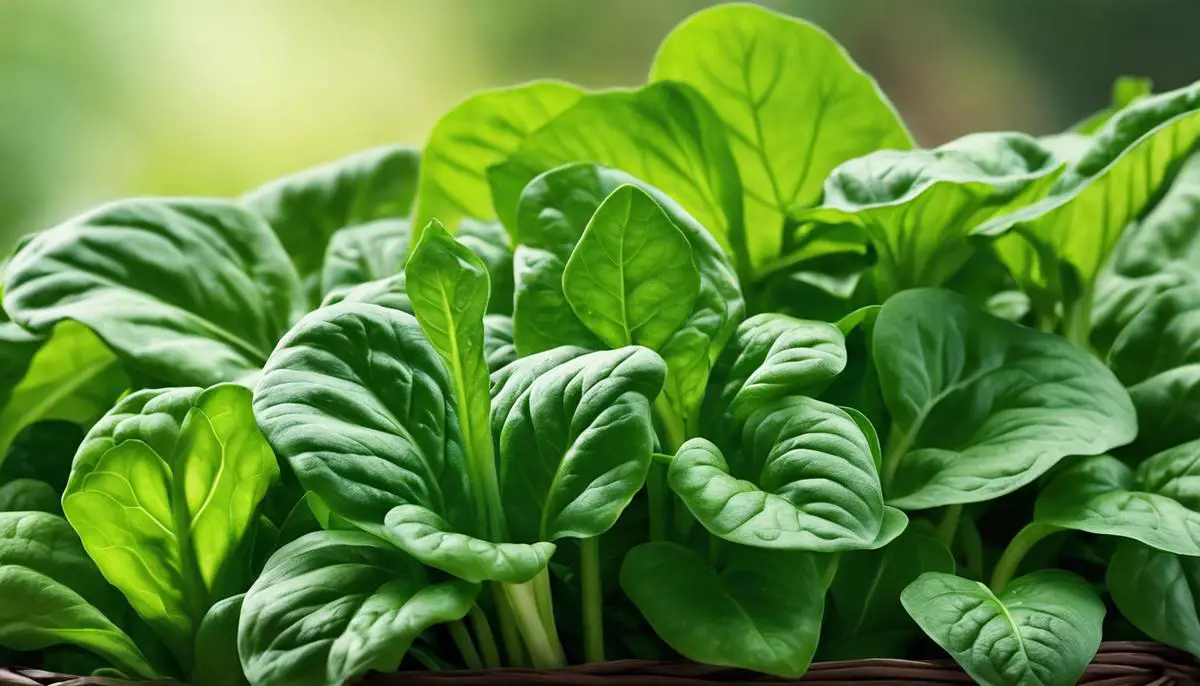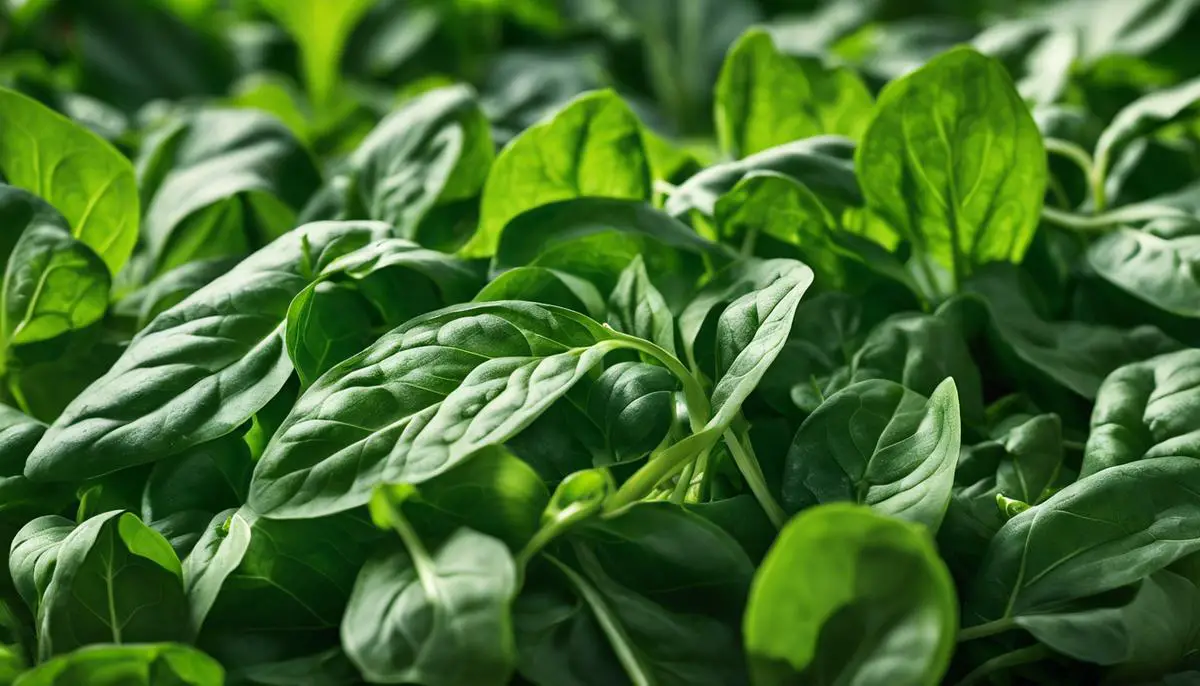Gardening enthusiasts and health-conscious eaters alike understand the significance of harvesting vegetables at just the right moment. Spinach, a nutrient-packed leafy green, is particularly delicate and requires careful timing and technique to harvest. With the intention of empowering gardeners to reap the most flavorful and nutrient-dense produce from their efforts, this guide will delve into the art of spinach harvesting. By focusing on recognizing when your spinach is ready to pick, mastering the most efficient and plant-friendly harvesting methods, and learning to handle your greens with care once plucked, you will transform your garden into a bastion of freshness and vitality.
Identifying Harvest Readiness
The Perfect Pick: Knowing When Your Spinach is Ready to Leap from Garden to Table
There’s something inherently joyful in the simple act of plucking fresh spinach from your very own garden—its vibrant green leaves practically vibrating with vitality and flavor, promising a world of culinary exploration. For the epicurean adventurer who revels in the kitchen, gardening provides an intimate connection to the ingredients that make our dishes sing. And with spinach, a versatile green that easily adapts from raw salads to comforting sautées, knowing exactly when to harvest can elevate a dish from delightful to sublime.
Reader Poll: What online courses would interest you?
Imagine the scene: you’re ambling through your garden, the sun is gleaming with promise, and your spinach, yes, the very embodiment of green goodness, is flirting with the idea of harvest. But how do you know when it’s truly ready to be the star of your next gastronomic escapade?
Size Matters, Truly: Check the Leaves!
Spinach is something of a sprightly youngster in the garden, keen to show off its tender leaves early in life. Patience, while a virtue, isn’t too necessary here—once the leaves reach about the size of a hearty baby spinach you find at the market, around 3 to 4 inches in length, they’re ready for the picking. But don’t be shy; larger leaves are also ripe for the taking, especially if a robust spinach presence is what you’re after.
Subscribe to our newsletter!
Look for the Texture Tell-Tale: Crisp and Firm Wins the Day
A prime spinach leaf is like a well-crisped chip, exuding a sense of firmness that speaks to its freshness. If the leaves are standing proud and delaying that inevitable wilt, they are practically begging to be plucked. When you tenderly squeeze a leaf between your fingers and it shows a bit of resistance, it’s shouting out its ripeness!
The Art of the Pick: Gentle and Gradual
When you’re ready to harvest, don’t be overly eager and strip the plant bare. Be an artist—pick a little here, a little there, always choosing the outer leaves first. This selective snipping encourages the plant to flourish and keep producing those delectable leaves. Use a sharp knife or scissors, and cut close to the base of the leaf stalk, being careful not to bruise the other leaves.
The Youthful Center: A Sign of Continued Bounty
Observe the center of the spinach plant—that’s where the young, tiny leaves are just starting to make their mark on the world. This youthful center is a crucial sign of the plant’s ongoing growth. So long as these baby leaves are present and accounted for, your spinach can keep on giving.
Timing is Everything: Enjoy the Cool of the Day
For peak flavor, sneak into your garden in the early morning or as the evening cools. This is when your spinach is most hydrated and bursting with flavor. The midday sun, while glorious, can make the leaves listless and less than perfect for your palate.
In the end, knowing when to harvest spinach hinges on a delicate dance of size, texture, and timing. Listening to your garden’s whispers can lead to the boldest of flavors on your table. When you pluck that perfect leaf, tender yet robust, consider the world of flavors that await—be it sautéed with garlic, tossed fresh in a salad, or folded into a sumptuous omelet. The joy of harvesting is just the beginning of a delicious journey enjoyed with friends and loved ones. And remember, in the garden of life, every meal shared is a leaf worth savoring.

Harvesting Techniques
Heading into the garden with a basket in hand and dew still fresh on the ground, one might feel an eager anticipation at the promise of what fresh spinach could bring to the table.
Now, having understood the when and why of spinach harvesting, it’s crucial to delve into the how, ensuring that every delicate leaf can fulfill its culinary destiny without sacrificing the vitality of the plant it calls home.
To embark on this verdant venture, one requires nothing more than deft fingers and a keen eye. For those culinary adventurers who seek the freshest ingredients, the technique is simple. Cup the leaf gently and grasp the stem close to the base; a swift, precise tug is all that’s needed, and the leaf comes away like the last note of a symphony—complete, clean, and without a trace of violence to mar the plant’s verdant crescendo.
There’s a rhythm to it, a sort of green-thumb choreography. Alternate which leaves are harvested, never denuding a single area, but rather pirouetting around the plant, harvesting some mature leaves from each section. This encourages the plant to redistribute its resources, sparking a proliferation of new growth that’s as relentless as a foodie’s appetite for discovery.
It’s this graceful snatching away of the outer leaves that spares the inner sanctum, the burgeoning center where future leaves dream of their place in sun-kissed fields. Wise harvesters know that these central leaves are the plant’s insurance policy, securing a legacy of leafy goodness for weeks, even months, to come.
And though the harvesting process is an art in itself, let’s not forget the spotlight’s true occupant: the spinach. Freshly harvested, it whispers promises of earthy salads scattered with just-picked heirloom tomatoes, sumptuous quiches that exhale steamy secrets, or a vibrant saag that hums with the harmonies of well-blended spices. Each meal becomes not just nourishment, but a narrative—a shared experience steeped in the flavors of life and the joys of communal dining.
In the embrace of the kitchen, every new technique learned, every fresh flavor explored is a story to recount, a memory to savor. And when gathered around a meal, every forkful carries with it the care and respect for the process that started with the gentle tug of a spinach leaf. In the end, it’s not just a meal that’s been cultivated, but a sense of connection—to the earth, to the ingredients, to each other—that is the most bountiful harvest of all.

Post-Harvest Handling
Securing the Succulence: Preserving Your Harvested Spinach
So you’ve mastered the art of harvesting spinach, the delicate yet robust green that’s as versatile as it is nutritious. But the journey from garden to plate requires a quick yet careful approach to ensure every leaf maintains its freshness. Let’s dive into the essentials of preserving your bountiful greens post-harvest.
Chilling Out: The First Step to Freshness
After you’ve plucked the perfect leaves, swift refrigeration is essential. Spinach, like your freshest salad greens, craves the cold. Aim to refrigerate your spinach within two hours of harvesting to lock in that just-picked flavor. The crisp environment of your fridge slows down the decay process, keeping those leaves lively and lush.
Water: Friend or Foe?
Moisture can be spinach’s greatest ally or its worst enemy. Before stowing your spinach away, give it a gentle, thorough rinse under cool water to remove any lingering dirt or critters. But here’s the crux — ensure the leaves are completely dry before refrigeration. A salad spinner works wonders, whisking away excess water. If you’re spinner-less, blot the leaves carefully with kitchen towels or let air do the work.
Packaging with Panache
Forget about stuffing those verdant leaves into whatever plastic bag you find. Give them the VIP treatment they deserve: a storage container or bag that allows breathability will work wonders. If you’re using a reusable container, lay a paper towel inside to absorb any residual moisture, avoiding a wilted mess. Those going the bag route might leave it partially open for a breath of fresh air, or poke a few holes for ventilation.
Layering: A Delicate Balloon Dance
When storing spinach, think of layering leaves like inflating little individual balloons with love – gently and with intention. Don’t compress or overcrowd them; always treat them like the delicate treasures they are. This prevents bruising and helps maintain that just-picked structure and texture.
Timing is Everything
For the freshest taste, use harvested spinach within a week — the sooner, the zestier. As days pass, even well-stored spinach will inevitably begin to lose its vivaciousness.
Frosty Relations: Freezing for the Future
For those not planning an immediate spinach soirée, consider freezing as your go-to preservation method. Blanching spinach prior to freezing – plunging it into boiling water for just about two minutes, followed by an ice bath – can preserve flavor and texture. After blanching, dry thoroughly, divide into portions, and pack in freezer-friendly bags.
The Culinary Crusade Continues
Once preserved, the culinary escapades are limitless. Incorporate those vibrant greens into creamy dips, robust sautés, or fresh smoothies. Whether creating a savory pie that exudes rustic charm or whipping up an elegantly dressed salad that could wow at any dinner party, each bite echoes the care taken from garden to kitchen.
Embrace each step in the process as a dance with nature, nourishing oneself and others with the bounty of our planet. The satisfaction of a meal prepared with ingredients tended by your own hands is a simple yet profound joy that every food connoisseur cherishes. Now, with your greens gloriously preserved, the only question remaining is, what culinary masterpiece will grace your table tonight?

Mastering the art of spinach harvesting is a journey that evolves with time and practice. By bringing together the knowledge of when to harvest, the finesse required during the process and the significant aspects of post-harvest handling, you’re poised to enjoy spinach that embodies the essence of home-grown goodness. As the seasons change and your expertise grow, these techniques will become second nature, allowing you to sustainably enjoy the fruits of your labor for many harvests to come. Here’s to the vibrant leaves that await your table, the satisfaction of well-nourished plants, and the joy of gardening that enriches both the body and the spirit.

